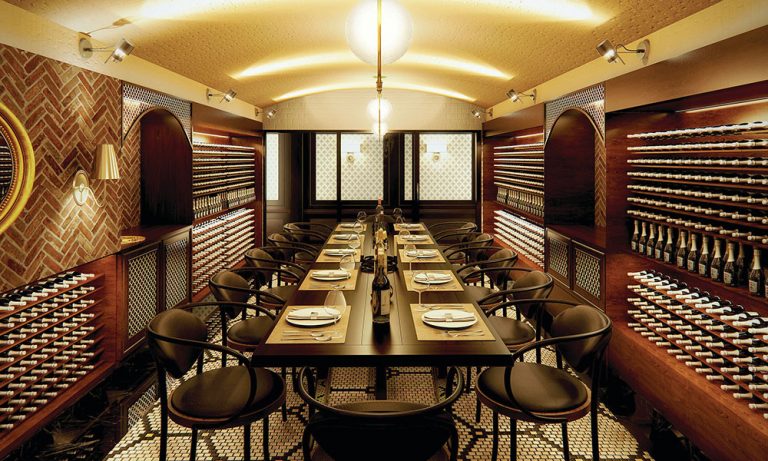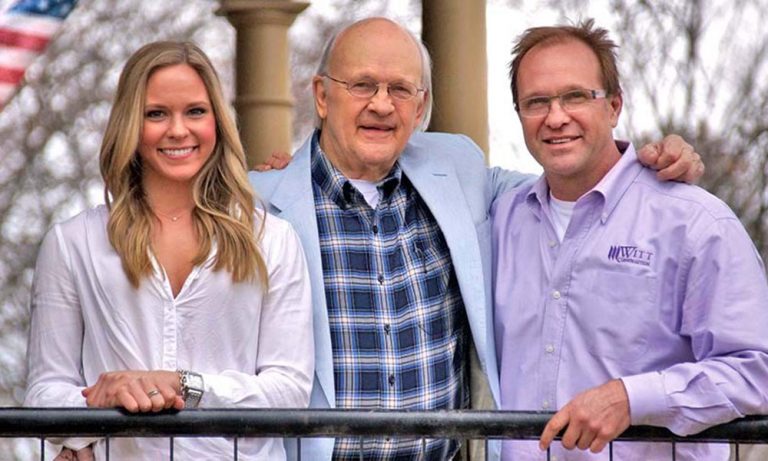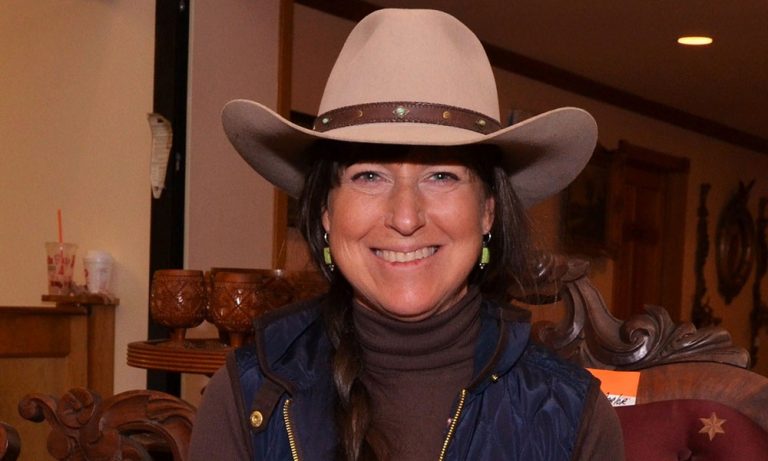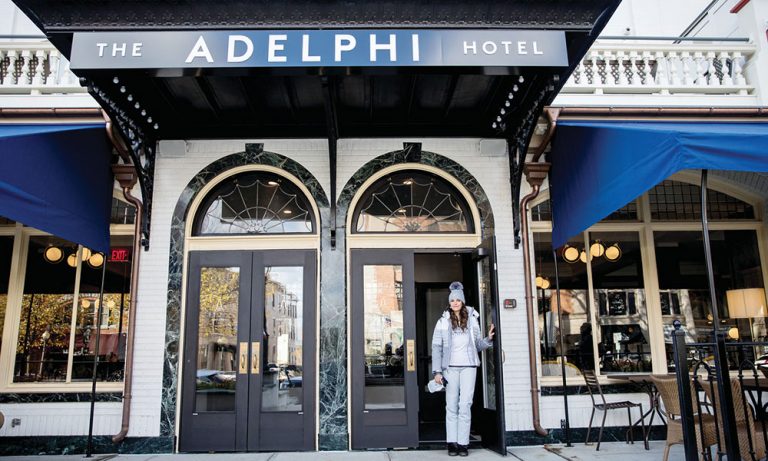Folk singer Sawyer Fredericks, at left, made his debut performance at Caffè Lena when he was 14. At 16, he won The Voice and had a SPAC gig. This May, he’s returning to Caffè Lena for a sold-out series of concerts.
Homegrown, rooted, locally bred, organic, pure, raw. Much like the produce at the Greenfield Farmer’s Market where he loved to play, Sawyer Fredericks is all that—the real deal. He is a musical artist, a singer-songwriter with crystal clear blue eyes and long golden locks, singing original songs in his own unique style. His voice resonates with millions who feel it, too.
Sitting on the front porch of his family’s farmhouse in the late daylight of spring, listening to Sawyer strum his guitar, there is no need, for the moment, to ask him questions. Sometimes answers come simply by observing. One of the dogs, a chocolate lab named Tanner, is at our feet, relentlessly wanting to play Frisbee. It is peaceful and serene—a relaxing immersion in the rural landscape.
On the 88-acre farm in Fultonville, a village in Montgomery County, Sawyer was homeschooled by his mother, Kirsten, from the age of five, as were his two older brothers, Aric and Skyler. “It definitely helped me with my music,” Sawyer says. “It gave me a lot of freedom, allowed me to pursue the kind of style that I wanted. I just had more time to enjoy it. I started music lessons when I was eight years old. I hated it; I stopped completely. Then my uncle taught me three chords.” He plays D-A-G. “I was 11 years old, and I was like…all right!” he says with a laugh. “The type of home school we did was ‘Un-schooling,’ which is self-directed learning, and learning through life. So, basically, anything that I am doing is my school.” Sawyer laughs again. “We’re all learning through life.”
This philosophy probably gave him the ability to segue from his very private life on the farm to The Voice competition on NBC. “I actually didn’t go out for the open audition. They found me on YouTube. A scout found some of my farmer’s market videos and invited me to an audition, which was after the open call auditions. I auditioned twice before the actual live audition on TV. I wasn’t sure if I wanted to do it because it’s not my kind of thing. I didn’t really believe in putting music into a competition, and I was very introverted. Having all the cameras and interviews, that was very scary to me. Going into it, I really just had to think of it as a learning experience…all right, let’s see what happens.” And happen it did.
Sawyer greets a steer named Hudson on the family farm.
His choice to sing the traditional folksong “Simple Man” for his blind audition got him a four-chair turn. Ultimately, as the 2015 winner of The Voice—Season 8, 16-year-old Sawyer Fredericks, the youngest to win on the show watched by millions of people, was awarded a recording contract, a new car he gave to his parents, and a cash prize that he has invested into his new recording, publishing and touring companies.
Being among the millions who had watched the show and voted for him, with tears in my eyes when he won, I asked Sawyer why his music resonated with so many people. “I think that my voice was a little bit of a shock for people. My style is very different from other artists on the show. I connected with a little bit older audience who connected back to their roots, the music that they listened to and a style that is missing today—like I was bringing them back to their childhood.”
I love being out in the summer when we’re cutting down all the fields, and bailing all the hay.”
“The whole experience was definitely a good one. I learned so much. It allowed me to come out of my shell,” he says. “I got to be around so many other talented artists; it was my first time being around so many musicians. It was crazy.” Asked to reflect on his journey, he says, “There were a lot of things that surprised me—the inner workings of everything. I kind of had to put this weight on my character, like being asked the question, ‘Tell me about yourself.’ I had never had that asked of me before. I said, ‘Well, what do you want to know?’”
Two weeks before winning The Voice, Sawyer thrilled the hometown crowd at the Fonda Speedway; just after his win, he played the Palace Theater in Albany and Fly 92’s Summer Jam at the Saratoga Performing Arts Center. He encouraged his fans through Twitter to vote for SPAC, which won the USA Today’s readers’ poll as Best Outdoor Music Venue in the country in June 2015. “I loved performing there,” he emailed SPAC. “The sound is incredible for an outside concert, and it’s just a beautiful park, too.”
In 2016, Sawyer released his first major label album, A Good Storm, and toured throughout the United States, playing at over 70 locations. He wrote (or co-wrote) every song on the album.
He is an independent artist now, no longer under contract with Republic Records. His eyes sparkle: “It means I have a lot more freedom with my music when I start recording my new record. I’m just excited to get into the studio and work on new music.” With his new band— cousin Arthur Lee Fredericks on bass, Chris Thomas on drums, and Jerome Goosman on guitar—Sawyer is looking for a more organic approach in a naturally flowing atmosphere. “Just figuring out how I want my songs to be recorded, and how I want them to work with a full band,” he says.
He shares a bit about his creative process: “I just start playing guitar. I get the melody, and figure out what kind of story I want to tell, and kind of move from there.” Of his new project, he offers, “the themes in each song will connect to each other on the album,” which is expected to be out sometime this year.
He seems to be most comfortable with his solitude, alone with his music.
Sawyer celebrated his 18th birthday at the end of March, with no fanfare and no cake. “I’m not much of a cake guy,” he says. “I just had some friends come over… very chill.”
With the freedom now to choose his own path, Sawyer is also returning to the venue that made an indelible mark on his young career. At the end of May, he will perform on the newly renovated Caffè Lena stage in Saratoga Springs for a special three-night engagement, which sold out in less than eight hours. His fans are calling his Caffè Lena homecoming “Sawyertoga” Weekend. They are traveling from around the world, with one devoted fan traveling from South Africa.
He first stood on the Caffè Lena stage at a Monday night “open mic” when he was 14 years old. He recalls, “It seems like so long ago. I was pretty nervous because I was just starting out. It was a little much for me.” He was so well received that Executive Director Sarah Craig invited him to open for The Kennedys shortly thereafter. Of the importance of the coffee house, Sawyer says, “I think that it’s just a great place to allow young artists to perform and not feel judged. It’s a very calming environment, surrounded by other artists, which is also a very good experience. For an upcoming artist, you don’t feel like you’re alone in this.”
Caffè Lena, which holds the distinction of being the oldest continuously running coffee house in the country, has hosted thousands of young and seasoned artists since opening its doors in 1960, including the emerging Bob Dylan.
Although the intimate, 118-seat venue is sold out for Sawyer’s return show, his fans around the world will be able to experience the show via a high-definition digital pay-per-view. Or they can catch his July 22 concert at the 2017 Paw Picnic in North Chatham, a benefit for the Columbia-Greene Humane Society.
In conversation, he speaks the words “my fans” gently. “It means a lot to me, knowing that I have so many people supporting me who are interested in my music. It’s amazing having that many people listening.” Sawyer has an official fan club, a few not so “official” ones, and a huge following on Facebook, Twitter and Instagram.
It’s a lot to think about and maintain, a task lovingly coordinated by his mom (and manager) Kirsten Fredericks. She says of her husband, Carl, and three sons, “All the boys don’t plan too far ahead. I’m the one with the calendar and the lists.” Her attention to detail allows Sawyer the space to create. “He’s very much in the moment. It’s a very healthy way of being,” she says.
How does she keep it all organized and balanced: the travel, the performing, farming and family? “‘Have tos’ and ‘shoulds’—I am against those words in general. So it is really about setting limits and doing it in a way that works for us, especially Sawyer.”
When he’s not working on his music, “Well, I live on a farm and I have all of my farm chores,” Sawyer says. His least favorite: “probably mucking the chicken stalls… but the eggs are nice.” His most favorite: “Haying season. Just because I love being out in the summer when we’re cutting down all the fields, and bailing all the hay.”
“For fun, I am a gamer. I play a lot of games,” he says. It is something he enjoys doing with his brothers. “I wouldn’t say that I am very tech savvy, but I do have an X-Box. I watched a good amount of television when I was younger. I watched tons and tons of movies, a lot of Quentin Tarantino movies, Pan’s Labyrinth, Sweeney Todd, Gangs of New York, Ferris Bueller’s Day Off. I watched that thing about 10 times.”
As we strolled around the farm, I met Django, a boar of impressive size; pigs and piglets; a new calf who will be named either Sergio or Sesame. I lingered by a fallen tree by the pond; Sawyer effortlessly climbed up it with his guitar. He seemed to be most comfortable with his solitude, alone with his music. Interviews may not be among his favorite things; nevertheless, he was genuine and unfiltered. It translates to his music. Some musicians reach out beyond words and melodies. Sawyer Fredericks has that gift.









